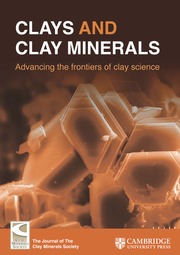Crossref Citations
This article has been cited by the following publications. This list is generated based on data provided by
Crossref.
Johnston, Cliff T.
Wang, Shan‐Li
and
Griffiths, Peter R.
2001.
Handbook of Vibrational Spectroscopy.
Johnston, Cliff T.
and
Premachandra, Gnanasiri S.
2001.
Polarized ATR-FTIR Study of Smectite in Aqueous Suspension.
Langmuir,
Vol. 17,
Issue. 12,
p.
3712.
Johnston, Cliff T.
de Oliveira, Maurilio Fernandes
Teppen, Brian J.
Sheng, Guangyao
and
Boyd, Stephen A.
2001.
Spectroscopic Study of Nitroaromatic−Smectite Sorption Mechanisms.
Environmental Science & Technology,
Vol. 35,
Issue. 24,
p.
4767.
Johnston, C. T.
Sheng, G.
Teppen, B. J.
Boyd, S. A.
and
de Oliveira, M. F.
2002.
Spectroscopic Study of Dinitrophenol Herbicide Sorption on Smectite.
Environmental Science & Technology,
Vol. 36,
Issue. 23,
p.
5067.
Greathouse, Jeffery A.
and
Storm, Erik W.
2002.
Calcium hydration on montmorillonite clay surfaces studied by Monte Carlo simulation.
Molecular Simulation,
Vol. 28,
Issue. 6-7,
p.
633.
Johnston, Cliff T.
Agnew, Stephen F.
Schoonover, Jon R.
Kenney, John W.
Page, Bobbi
Osborn, Jill
and
Corbin, Rob
2002.
Raman Study of Aluminum Speciation in Simulated Alkaline Nuclear Waste.
Environmental Science & Technology,
Vol. 36,
Issue. 11,
p.
2451.
Madejová, J
Janek, M
Komadel, P
Herbert, H.-J
and
Moog, H.C
2002.
FTIR analyses of water in MX-80 bentonite compacted from high salinary salt solution systems.
Applied Clay Science,
Vol. 20,
Issue. 6,
p.
255.
Goldberg, Sabine
2002.
Competitive Adsorption of Arsenate and Arsenite on Oxides and Clay Minerals.
Soil Science Society of America Journal,
Vol. 66,
Issue. 2,
p.
413.
Post, James L
and
Borer, Londa
2002.
Physical properties of selected illites, beidellites and mixed-layer illite–beidellites from southwestern Idaho, and their infrared spectra.
Applied Clay Science,
Vol. 22,
Issue. 3,
p.
77.
Johnston, Cliff T.
Wang, Shan‐Li
and
Hem, Stanley L.
2002.
Measuring the surface area of aluminum hydroxide adjuvant.
Journal of Pharmaceutical Sciences,
Vol. 91,
Issue. 7,
p.
1702.
SUZUKI, Satoru
KAWAMURA, Katsuyuki
NAKASHIMA, Yoshito
and
ICHIKAWA, Yasuaki
2003.
The Study of Correlations between Spectroscopic and Dynamic Properties of Pore Water in the Clay-water System.
Shigen-to-Sozai,
Vol. 119,
Issue. 9,
p.
581.
Madejová, J
2003.
FTIR techniques in clay mineral studies.
Vibrational Spectroscopy,
Vol. 31,
Issue. 1,
p.
1.
Yariv, S.
and
Lapides, I.
2003.
Laser Shadow Analysis of Particle-Size Distribution of Montmorillonites in Aqueous Suspensions.
Clays and Clay Minerals,
Vol. 51,
Issue. 1,
p.
23.
Ras, R. H. A.
Johnston, C. T.
Franses, E. I.
Ramaekers, R.
Maes, G.
Foubert, P.
De Schryver, F. C.
and
Schoonheydt, R. A.
2003.
Polarized Infrared Study of Hybrid Langmuir−Blodgett Monolayers Containing Clay Mineral Nanoparticles.
Langmuir,
Vol. 19,
Issue. 10,
p.
4295.
Wang, Shan-Li
Johnston, Cliff T
Bish, David L
White, Joe L
and
Hem, Stanley L
2003.
Water-vapor adsorption and surface area measurement of poorly crystalline boehmite.
Journal of Colloid and Interface Science,
Vol. 260,
Issue. 1,
p.
26.
Suzuki, Satoru
and
Kawamura, Katsuyuki
2004.
Study of Vibrational Spectra of Interlayer Water in Sodium Beidellite by Molecular Dynamics Simulations.
The Journal of Physical Chemistry B,
Vol. 108,
Issue. 35,
p.
13468.
Dontsova, Katerina M.
Norton, L. Darrell
Johnston, Cliff T.
and
Bigham, Jerry M.
2004.
Influence of Exchangeable Cations on Water Adsorption by Soil Clays.
Soil Science Society of America Journal,
Vol. 68,
Issue. 4,
p.
1218.
Teppen, Brian
Sheng, Guangyao
Boyd, Stephen
and
Johnston, Cliff
2004.
Handbook of Layered Materials.
Hongping, He
Ray, Frost L.
and
Jianxi, Zhu
2004.
Infrared study of HDTMA+ intercalated montmorillonite.
Spectrochimica Acta Part A: Molecular and Biomolecular Spectroscopy,
Vol. 60,
Issue. 12,
p.
2853.
Whitley, Heather D.
and
Smith, David E.
2004.
Free energy, energy, and entropy of swelling in Cs–, Na–, and Sr–montmorillonite clays.
The Journal of Chemical Physics,
Vol. 120,
Issue. 11,
p.
5387.

